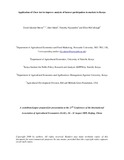| dc.description.abstract | High population growth rates and emergence of urban settlements provide opportunities as
well as challenges to economic development in many countries. While the supply of labour and
markets are potential positive outcomes of these processes, the underlying pressure on scarce
resources is often intense. In low-income agriculture-dependent countries such as Kenya,
inadequate food supply and lack of other basic social amenities characterize a large share of rural
and urban population. The productive capacity and commercial orientation of agriculture and foodrelated
sectors need to be improved in order to reduce famine, malnutrition and poverty. This would
entail enhancing farmers’ access and participation in both input and out markets.
Horticulture (especially vegetables) is one of the most important sectors in Kenya, where
smallholder farmers account for nearly 70% of the output (McCulloch and Ota, 2002). About 23%
of Kenya’s export revenue is derived from horticultural exports (CBS, 2006; Minot and Ngigi,
2003). Cultivation of vegetable crops (mainly cabbages, tomatoes, kales – sukuma wiki, onions and
a variety of indigenous vegetables such as amaranthus) forms a crucial source of livelihood for
many households in rural and peri-urban areas of Kenya (Omiti et al., 2004).
Promoting investments in agricultural commercialization, more so in developing marketing
channels are critical for poverty reduction (Geda et al., 2001). The potential benefits of higher
product prices and lower input prices due to commercialization are effectively transmitted to poor
households when markets function fairly (IFAD, 2001). In Kenya, recent research show evidence
that prioritizing infrastructure development for vegetable production and marketing are necessary
for improvement of most livelihoods (Omiti et al., 2006).
Recent transformations in agri-food systems (particularly the rise of supermarkets and
technological advances in developing countries’ agriculture during the last decade) offer
opportunities for smallholder farmers (McCullough et al., 2008). However, these prospects might
2
be countered by population pressure, on-going global economic downturn and the adverse effects of
climate change, if alternative policies and strategies are not urgently instituted to reverse the decline
in real purchasing power of many households (Food Ethics Council, 2008). In order to support the
process of sustained economic growth, there is need for a more refined and targeted analysis of
pertinent issues that constrain farm-to-market distribution of food. The analytical role of
agricultural economists must therefore expand to comprehensively capture site-specific dynamics of
the agri-food systems.
Previous studies on market participation (for example, Alene et al., 2008; Chianu et al.,
2008; Makhura et al., 2002) have been based on single or multiple sites. However, the decision to
pool data or perform separate analysis is often subjective. In these studies, authors provide elaborate
discussions to differentiate sites in terms of geographic features, climatic conditions and socioeconomic
profiles. Although the findings from such studies might offer useful insights on necessary
policies, they lack rigorous objective criteria to support the choice between pooled versus
disaggregated analyses. It is important to anchor market analysis on solid statistical criteria in order
to give more credence to the resulting site-specific or nation-wide strategies. This would enable
implementation of policy interventions that reliably address salient challenges which may vary
across sub-regions within a country. As a standard practice, data from multiple sites should be
tested to confirm similarities or differences, and to guide the process of data organization (pooling
or separation) for analysis.
This study contributes to knowledge on farm-level analysis of market participation through
application of the Chow’s seminal test (Chow, 1960) to examine differences between data from two
sites (rural and urban). A truncated regression model is applied in the analysis.
The specific objectives of the study are:
i. To assess difference in the level of market participation between rural and peri-urban
farmers;
ii. To estimate factors that influence the share of vegetable marketed by farmers. | en |

